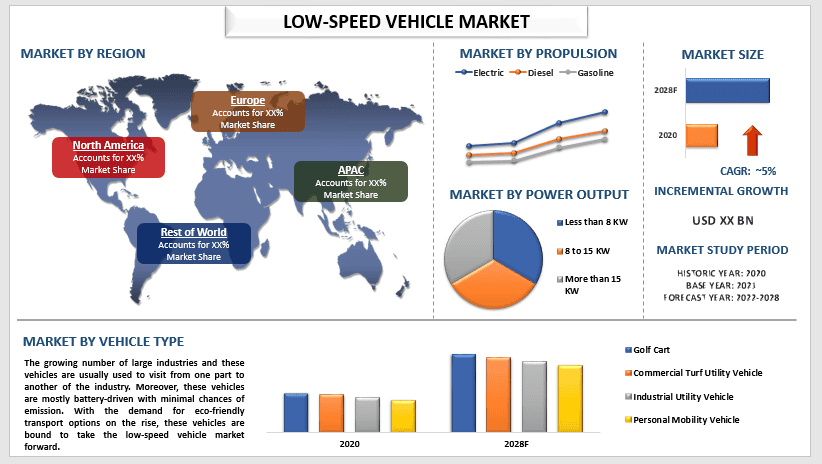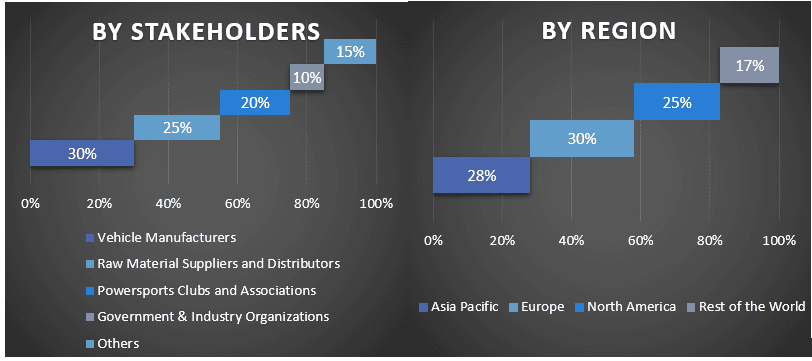- Home
- About Us
- Industry
- Services
- Reading
- Contact Us
Low-Speed Vehicle Market: Current Analysis and Forecast (2022-2028)
Emphasis on Vehicle Type (Golf Cart, Commercial Turf Utility Vehicle, Industrial Utility Vehicle, and Personal Mobility Vehicle); Propulsion (Electric, Diesel, and Gasoline); Power Output (Less than 8 KW, 8 to 15 KW, and More than 15 KW); and Region/Country

Global Low-speed vehicle Market is expected to grow at a significant rate of around 5% during the forecast period 2022-2028. A low-speed vehicle is defined as a four-wheeled vehicle that has a maximum capable speed of typically 25mph. These vehicles are used as industrial vehicles, neighborhood vehicles, and golf carts. Moreover, it is easy to drive the vehicle and find the applications in golf courses, schools, colleges, university campuses, airports, railway stations, factories, and hospitals. In addition, these vehicles are available in fuel engines as well as in electric motors. A higher rate of adoption of the battery-powered vehicle due to the rising preference for zero-emission vehicles, as they are pollution-free, is a major factor boosting the segment of the market. For instance, in 2021, the Department of Energy’s (DOE) Vehicle Technologies Office, US, estimated that the cost of an electric vehicle lithium-ion battery pack declined 87% between 2008 and 2021. Hence, the industry is on the way to resolving the challenge related to batteries, which would provide better solutions for the growth of the low-speed vehicle market.
Polaris Inc, Textron, The Toro Company, Yamaha Golf-Car Company, Deere & Company, Kubota Corporation, Columbia Vehicle Group Inc, Taylor-Dunn Manufacturing, Club Car LLC, and American Landmaster. are some of the key players in the market. Several M&As along with partnerships have been undertaken by these players to facilitate customers with hi-tech and innovative products/technologies.
Insights Presented in the Report
“Amongst vehicle type, Sport low-speed vehicles category to witness robust CAGR during the forecast period”
Based on vehicle type, the market is segmented into a golf cart, commercial turf utility vehicle, industrial utility vehicle, and personal mobility vehicle. The industrial utility category is to witness higher CAGR during the forecast period owing to the growing number of large industries and these vehicles are usually used to visit from one part to another of the industry. Moreover, these vehicles are mostly battery-driven with minimal chances of emission. With the demand for eco-friendly transport options on the rise, these vehicles are bound to take the low-speed vehicle market forward.
“Amongst propulsion, the electric to hold a significant share in the market in 2020”
Based on propulsion, the market is categorized into electric, diesel, and gasoline. Among these, the electric to hold a significant share in the market in 2020. Electric vehicles have low standard emissions and are environmentally friendly. The factors like low maintenance due to an efficient motor, better performance, no fuel require are some of the factors driving the growth of the market.
“North America to hold a significant share in the market”
For a better understanding of the market adoption of the Low-speed vehicle industry, the market is analyzed based on its worldwide presence in the countries such as North America (U.S., Canada, Rest of North America), Europe (Germany, U.K., France, Spain, Italy, Rest of Europe), Asia-Pacific (China, Japan, India, Rest of Asia-Pacific), Rest of World. Now, North America is in the lead. However, it is anticipated that during the projected period, the APAC area will grow the fastest. The supremacy of North America is based on its superior infrastructure and OEMs are planning to increase their production volume coupled with rapid technological advancements in manufacturing facilities in emerging regions such as the U.S., Canada, and Mexico, whereas the APAC region relies mostly on new industries that can advance the industry.
Reasons to buy this report:
- The study includes market sizing and forecasting analysis validated by authenticated key industry experts.
- The report presents a quick review of overall industry performance at one glance.
- The report covers an in-depth analysis of prominent industry peers with a primary focus on key business financials, product portfolio, expansion strategies, and recent developments.
- Detailed examination of drivers, restraints, key trends, and opportunities prevailing in the industry.
- The study comprehensively covers the market across different segments.
- Deep dive regional level analysis of the industry.
Customization Options:
The global low-speed vehicle market can further be customized as per the requirement or any other market segment. Besides this, UMI understands that you may have your own business needs, hence feel free to connect with us to get a report that completely suits your requirements.
Table of Content
Research Methodology for the Low-speed vehicle Market Analysis (2022-2028)
Analyzing the historical market, estimating the current market, and forecasting the future market of the global low-speed vehicle market were the three major steps undertaken to create and analyze the adoption of low-speed vehicles in major regions globally. Exhaustive secondary research was conducted to collect the historical market numbers and estimate the current market size. Secondly, to validate these insights, numerous findings and assumptions were taken into consideration. Moreover, exhaustive primary interviews were also conducted, with industry experts across the value chain of the global low-speed vehicle market. Post assumption and validation of market numbers through primary interviews, we employed a top-down/bottom-up approach to forecasting the complete market size. Thereafter, market breakdown and data triangulation methods were adopted to estimate and analyze the market size of segments and sub-segments of the industry pertains to. Detailed methodology is explained below:
Analysis of Historical Market Size
Step 1: In-Depth Study of Secondary Sources:
Detail secondary study was conducted to obtain the historical market size of the low-speed vehicle market through company internal sources such as annual reports & financial statements, performance presentations, press releases, etc., and external sources including journals, news & articles, government publications, competitor publications, sector reports, third-party database, and other credible publications.
Step 2: Market Segmentation:
After obtaining the historical market size of the low-speed vehicle market, we conducted a detailed secondary analysis to gather historical market insights and share for different segments & sub-segments for major regions. Major segments are included in the report as vehicle type, propulsion, and power output. Further country-level analyses were conducted to evaluate the overall adoption of testing models in that region.
Step 3: Factor Analysis:
After acquiring the historical market size of different segments and sub-segments, we conducted a detailed factor analysis to estimate the current market size of the low-speed vehicle market. Further, we conducted factor analysis using dependent and independent variables such as various vehicle type, propulsion, and power output of low-speed vehicles. A thorough analysis was conducted for demand and supply-side scenarios considering top partnerships, mergers and acquisitions, business expansion, and product launches in the low-speed vehicle market sector across the globe.
Current Market Size Estimate & Forecast
Current Market Sizing: Based on actionable insights from the above 3 steps, we arrived at the current market size, key players in the global low-speed vehicle market, and market shares of the segments. All the required percentage shares split, and market breakdowns were determined using the above-mentioned secondary approach and were verified through primary interviews.
Estimation & Forecasting: For market estimation and forecast, weights were assigned to different factors including drivers & trends, restraints, and opportunities available for the stakeholders. After analyzing these factors, relevant forecasting techniques i.e., the top-down/bottom-up approach were applied to arrive at the market forecast for 2028 for different segments and sub-segments across the major markets globally. The research methodology adopted to estimate the market size encompasses:
- The industry’s market size, in terms of revenue (USD) and the adoption rate of the low-speed vehicle market across the major markets domestically
- All percentage shares, splits, and breakdowns of market segments and sub-segments
- Key players in the global low-speed vehicle market in terms of products offered. Also, the growth strategies adopted by these players to compete in the fast-growing market
Market Size and Share Validation
Primary Research: In-depth interviews were conducted with the Key Opinion Leaders (KOLs) including Top Level Executives (CXO/VPs, Sales Head, Marketing Head, Operational Head, Regional Head, Country Head, etc.) across major regions. Primary research findings were then summarized, and statistical analysis was performed to prove the stated hypothesis. Inputs from primary research were consolidated with secondary findings, hence turning information into actionable insights.
Split of Primary Participants in Different Regions

Market Engineering
The data triangulation technique was employed to complete the overall market estimation and to arrive at precise statistical numbers for each segment and sub-segment of the global low-speed vehicle market. Data was split into several segments & sub-segments post studying various parameters and trends in the areas of vehicle type, propulsion, and power output in the global low-speed vehicle market.
The main objective of the Global Low-speed vehicle Market Study
The current & future market trends of the global low-speed vehicle market were pinpointed in the study. Investors can gain strategic insights to base their discretion for investments on the qualitative and quantitative analysis performed in the study. Current and future market trends determined the overall attractiveness of the market at a regional level, providing a platform for the industrial participant to exploit the untapped market to benefit from a first-mover advantage. Other quantitative goals of the studies include:
- Analyze the current and forecast market size of the low-speed vehicle market in terms of value (USD). Also, analyze the current and forecast market size of different segments and sub-segments
- Segments in the study include areas of vehicle type, propulsion, and power output.
- Define and analysis of the regulatory framework for the low-speed vehicle
- Analyze the value chain involved with the presence of various intermediaries, along with analyzing customer and competitor behaviors of the industry.
- Analyze the current and forecast market size of the low-speed vehicle market for the major region.
- Major countries of regions studied in the report include Asia Pacific, Europe, North America, and the Rest of the World.
- Company profiles of the low-speed vehicle market and the growth strategies adopted by the market players to sustain in the fast-growing market
- Deep dive regional level analysis of the industry
Related Reports
Customers who bought this item also bought










